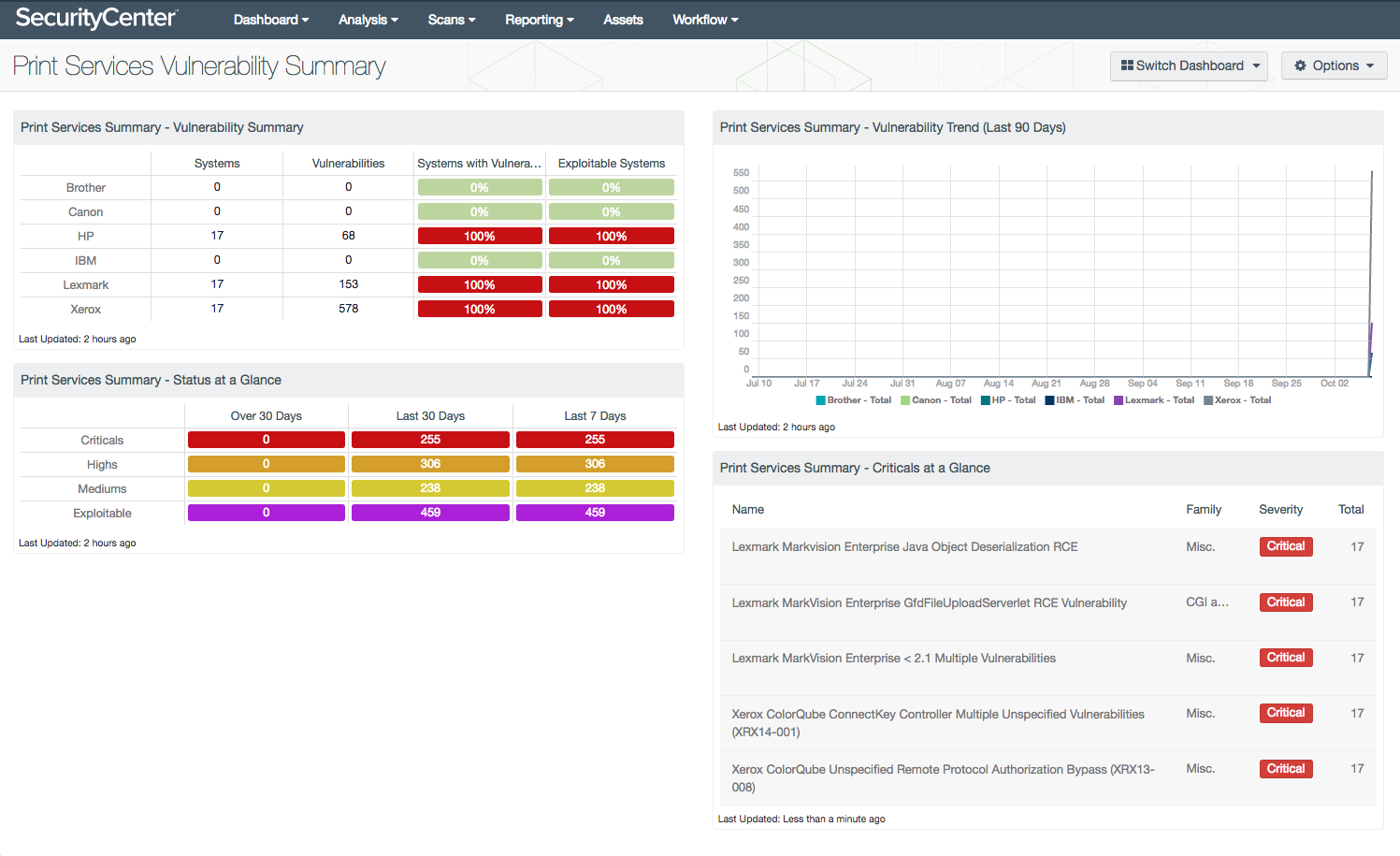by Megan Daudelin
November 4, 2016

Monitoring common printers and related services for vulnerabilities is essential to securing a network against exploitation. Printers and supporting services are essential to organizations of all sizes, and as a result are a target for attackers. By leveraging vulnerability data gathered by Tenable Nessus, Tenable SecurityCenter is able to provide detailed insight into vulnerabilities related to printers and services deployed in an environment.
The Print Services Vulnerability Summary dashboard provides insight into vulnerabilities associated with common printer vendors that may expose an organization to increased risk of exploitation. Vulnerabilities related to various vendors of printers are specifically tracked. Printers and supporting services are a requirement for most organizations, and as a result are targeted for exploitation. By monitoring the network specifically for vulnerabilities in printers and services, security teams can more effectively secure the network against exploitation and intrusion.
The components in this dashboard leverage data gathered by active vulnerability scanning with Nessus and passive vulnerability detection with Tenable Passive Vulnerability Scanner (PVS). The data collected is filtered to provide insight into the vulnerabilities related to printers and services in the environment. Vulnerabilities are tracked by time, severity, and exploitability in order to provide a more complete view of the security status of the network. Security teams can use all of the components in this dashboard to assist in identifying, monitoring, and remediating vulnerabilities in printers and services that may expose their organization to risk.
The dashboard uses the Common Platform Enumeration (CPE) filter to identify many of the software programs used in enterprise networks. According to NIST, the CPE is a structured naming scheme for information technology systems, software, and packages. Based upon the generic syntax for Uniform Resource Identifiers (URI), CPE includes a formal name format, a method for checking names against a system, and a description format for binding text and tests to a name. Tenable assigns CPEs to plugins where appropriate. This allows for analysts to search for common CPE prefixes such as “cpe:/h:xerox:,” “cpe:/h:hp:laserjet,” and “cpe:/a:lexmark:markvision.” Associating CPE strings with vulnerabilities allows the analysts a greater view into separating operating system vulnerabilities from application vulnerabilities, and adds to the level of vulnerability detail provided to the organization.
This dashboard is available in the SecurityCenter Feed, a comprehensive collection of dashboards, reports, Assurance Report Cards, and assets. The dashboard can be easily located in the SecurityCenter Feed under the category Threat Detection & Vulnerability Assessments. The dashboard requirements are:
- SecurityCenter 5.3.1
- Nessus 6.8.1
Tenable SecurityCenter provides extensive network monitoring by leveraging a unique combination of detection, reporting, and pattern recognition utilizing industry recognized algorithms and models. SecurityCenter is continuously updated to detect advanced threats and vulnerabilities. Tenable constantly analyzes information from our unique sensors, delivering continuous visibility and critical context and enabling decisive action that transforms the security program from reactive to proactive. Continuous vulnerability analysis enables security teams to more effectively tailor remediation efforts. Monitoring the network to ensure that all systems are secured against vulnerabilities is essential to ongoing security efforts. Tenable’s extensive network monitoring capabilities can verify that systems are successfully scanned regularly and secured against vulnerabilities, enabling ongoing improvements to an organization’s security posture.
The following components are included in this dashboard:
- Vulnerability Summary: This matrix displays information about the systems and vulnerabilities detected on the network, listed by printer or service vendor.
- Status at a Glance: This matrix displays the counts of vulnerabilities related to printers and services by severity and discovery date.
- Vulnerability Trend (Last 90 Days): This trend chart depicts the detection of vulnerabilities related to specific vendors of printers and services over the last 90 days.
- Criticals at a Glance: This table lists the critical vulnerabilities related to printers and services detected in the environment.